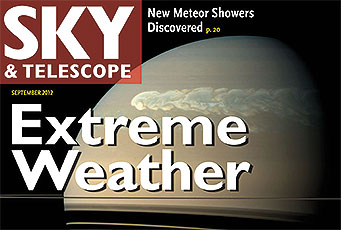Sky & Telescope's September 2012 issue is now available to digital subscribers. Some print subscribers have already received it, and it's officially on-sale at newsstands starting September 1st.
Read the latest issue if you're a digital subscriber.
Find out more about digital subscriptions.
Purchase magazines in print or as PDF downloads.

September 2012 S&T
I love a good thunderstorm. There's something inexplicably exciting about the flash of lightning and the terrifying clap and rumble that follow. Back as a kid in my native Minnesota, I even used to get a kick out of tornado warnings until I saw the havoc Mother Nature can wreak.
But the weather we experience on Earth, no matter how extreme, is nothing compared to other solar system denizens. Bolts of lightning on Saturn carry a million times the punch of Earthly shocks. Dust devils on Mars tower 10 times higher than those on Earth. And Jupiter's Red Spot has already churned for hundreds of years, far outlasting any hurricane on Earth. This month's cover story guides us through extreme weather in the solar system, and the storms aren't just fun to read about. Understanding the full force of an alien storm is vital for future missions, human or robotic.
But there are some places where robotic missions, such as NASA's Dawn mission, don't have to worry about the weather. Airless Vesta, the solar system's second largest asteroid is one of those places. September's issue features close-up images that Dawn took while circling Vesta, achieving a resolution of less than 100 meters. Scientists think the ancient rock is something of a hybrid: part asteroid, part planet. Zooming in on its features (and they're not all craters) will tell scientists more about the origin of the solar system. Plus, see more close-ups of Vesta in our online gallery.
Early fall brings in the planets: Jupiter and Venus pair at dawn, and Uranus and Neptune once again come into view for an observing challenge. Plus, September brings several unusual occultations, including one that you just might be able to make out during the daytime!
There's lots to observe in September, but one project especially calls for attention. Observers in any hemisphere, with any size telescope, and any level of experience can participate. Longtime S&T contributor Sissy Haas is searching for observers of double stars to help her answer a question: How much aperture (the size of a telescope's main lens or mirror) do you need to split a double star, that is, observe two stars instead of one? The formula has long been known for double stars of roughly equal brightnesses, but for uneven doubles, there are no fewer than six published formulas. Sissy seeks to nail this question, and you can help!
From an in-depth guide to Cygnus's treasures to a new test report on a camera deigned specifically for astrophotography, the September issue has plenty to keep you busy this fall.
To find out more, read our online Table of Contents.
 0
0
Comments
You must be logged in to post a comment.